Globalization and Workforce Development
1.0 Introduction
Training and development program for the employees is one of the effective strategic planning of the organisation nowadays to enhance the skill and abilities to performance in the workplace and achieve future organisational success (Noe et al., 2017).
1.1 Background of the study
In the recent era of globalisation, all the organisations are concerned about improving the efficiency and capabilities of the employees, as they are the major stakeholders to achieve future organisational success and fulfil the organisational mission and visions. In this context, the organisations need to arrange training and development program to all the employees, so that they can improve their knowledge and technical skill to perform better and enhance their contribution in the organisation (Cascio, 2015). In the recent era of globalisation, the demand for data analysis and evaluation is increasing at a rapid rate where the requirement for NDC is also rising by the SMEs and also the multinational corporate firms to analyse the market rend and business evaluation for achieving future success. Hereby, it is necessary for NDC to arrange proper training program in order to train the employees for maximising their performance and fulfilling the needs and preferences of the customers and business clients across the international market.
1.2 Organisational background about NDC
The project focuses on understanding the training program in the National Data Collection (NDC) through which it is possible for the organisation to develop efficient skill and knowledge among the employees to perform better. The organisation NDC is excellent in providing data collection and analysis service for traffic engineer, and it is efficient in transport planning and market research the vision of the organisation is be the best consulting business providing to bring out the nest performance for all their clients. The mission of the company is to provide wide range of business consulting and data services to the SME and large enterprise. The professional support team is highly experienced to produce productive and accurate solutions for meeting the client’s needs. The business aims at increasing profits and enhancing performance by reducing its cost of operations (National data Collection, 2019).
1.3 Research objectives
The aim of the study is to analyse the existing training provisions for the junior employees in NDC and examine the training methods that increases individual competences. The objectives are,
To explore different training method in NDC for the development of the employees
To acknowledge the advantage and disadvantage of training the employees
1.4 Research questions
Does the training improve employee’s competences and how the training is effective for enhancing the performance of the employees?
Who is responsible for delivering the training in NDC?
What are the different types of training methods?

2. Literature review
The literature review is effective for gathering in depth understanding and knowledge about the training and development process of the employees. Through the literature review, the researcher can gather secondary sources of information for improving the understanding and knowledge so that the collected primary data can be evaluated further by applying the secondary information, theories and concept of training and development program at the organisational context.
2.1 Theories of training
According to the Kirkpatrick’s four stage model of training and development program, there are four stages, which are reaction, learning, behaviour and results. First of all, the management team and leader of the organisation needs to understand the reaction of the employees, whether they are interested or not and understand the training is favourable or not. In this regard the leader focuses on the training program which is suitable for the job role of the employees, and organisational vision and mission (Bratton and Gold, 2017).
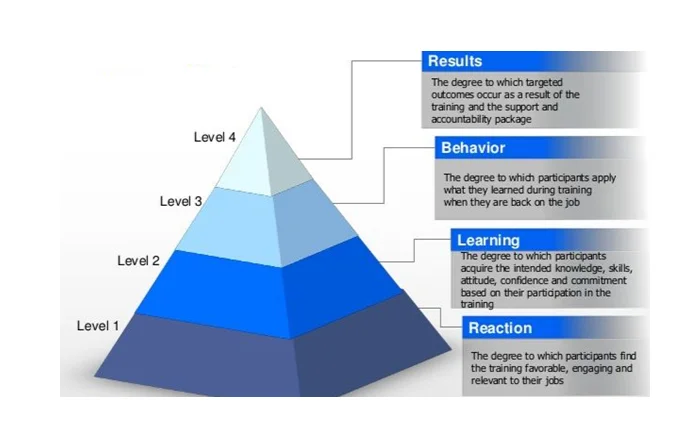
The second stage is learning, where the degree to which the participants acquire the intended knowledge, skill with proper learning attitude and confidence will be evaluated so that they can participate in the training program positively and has the mindset of acquiring more in depth knowledge for higher performance (Noe et al., 2015). The third stage is behaviour through which it is possible to apply the knowledge understanding on the job where the employees try to utilise their innovation and creativity for maximising the organisational objective by contributing positively. The fourth stage is result the actual outcome of the training can be evaluated by measuring the organisational performance as a whole (Chelladurai and Kerwin, 2018).
2.2 Importance of training
The training and development program is beneficial for the organisation to utilise the resource and capabilities for achieving sustainable growth of the company. Moreover, the productivity and efficiency of the staff members can be enhanced through providing proper training and development program (Brewster, 2017). The training program is considered to be an effective way to retain the staff and provide them to improve their personal and professional development for better performance in near future.

Developing positive attitude in the organisation as well as team work and communication and cooperation are also other impacts of training program, where the workers can share their knowledge and technical skill through training and development program as well as enhance communication and cooperation for contributing with their full potential to achieve the organisational success (Berman et al., 2019).
2.3 Training methods
There are two types of training method, on the job and off the job. Under the on the job training method, there are coaching, induction process for the employees, special project and task force, experience, changes the job role and position in the organisation and multiple management (Hanaysha, 2016). On the other hand, the off the job training are such as case study analysis, brain storming, conference, seminars and simulation, which are effective to enhance the knowledge and abilities of the employees at the organisation.

There are other training method such as on board training process, technical skill development training, products and service training and soft skill development training which are also beneficial for the employees to improve their capabilities by enhancing their technical skill and performance of the team as a whole.
3. Methodology
3.1 Data collection method
The methodology is beneficial for conducting the research in a systematic way by choosing proper research method and ethical consideration. In order to collect appropriate data and information, the researcher selects both the types of data collection method, which are primary and secondary data collection. In order to collect the secondary information, the researcher tries to review the existing books, journals and online articles as well as business letters so that it is easy to enhance skill and gather in depth knowledge about the above mentioned research topic. On the other hand, the primary data is also important in this research to gather first hand information directly from the employees and management team of the NDC. For collecting the primary data, questionnaire is one of the best techniques to collect information from the junior staff members in NDC. The data through primary data collection method will be gathered in 4th and 11th December so that the employee’s unwillingness due to Christmas can be avoided. In this regard, the researcher chooses the sample size of 50 junior staff to gather proper information which would be beneficial to analyse the research topic and fulfil its aims and objectives. The questionnaire in this regard is helpful to identify which type of training, provided to the employees for enhancing their performance and whether the training is effective for them or not. Apart from that, for gathering in depth data and information, the researcher arranged one to one interview with the 2 members of management team in order to understand the training method that they provide to the employees for better performance and achieving organisational success.
3.2 Data analysis method
For data analysis, the organisation focuses on the qualitative and quantitative data analysis technique, where through the quantitative data analysis, the primary data will be analysed and evaluated through charts and tables. On the other hand, the interview transcript will be analysed through qualitative data analysis technique, where the researcher will evaluate the findings through the interview with the management team by utilising the secondary information, collected from the review of literature.
3.3 Ethical consideration
Ethical consideration is necessary for the research paper, where the researcher ensures the validity and reliability of the data so that the collected data will be effective for analysing the research topic efficiently. In addition to these, the Data Protection Act 1998 is implemented in order to protect the collected information directly from the employees and management team of the NDC. In addition to these, the consent form is effective to ensure that the participants are safe to provide authentic information and the researcher also assures that the gathered information are utilised for this research paper, not for other purpose. The researcher also tries to convince the participants and did not force the respondent to take active part. Honesty and integrity as well as transparency and accountability are helpful for the researcher to convince the participants and get valid information directly from them in order to analyse the research topic efficiently.
4. Findings
4.1 Primary data collection
Questionnaire survey:
1. Do you agree that your organisation consider training program as a part of organisational strategy?


2. What kind of training method, do you prefer?

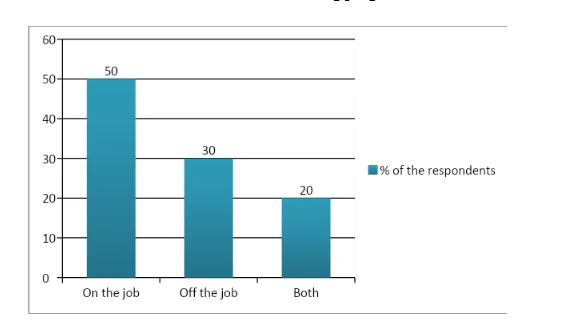
3. What kind of training method, does the organisation provide to train the employees?
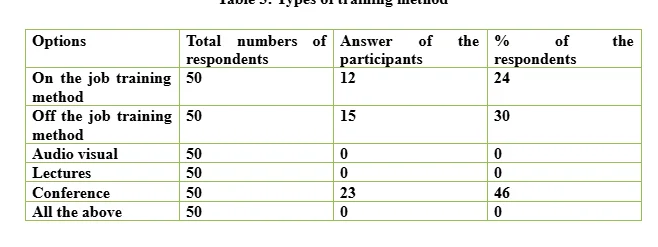
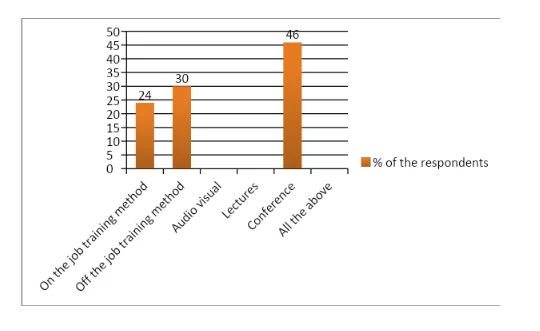
4. How often the training program is conducted in the workplace of the organisation?


5. Do you agree that, the training program helps to increase the productivity of both the quality and quantity?


6. Are you interested to participate in the training program?

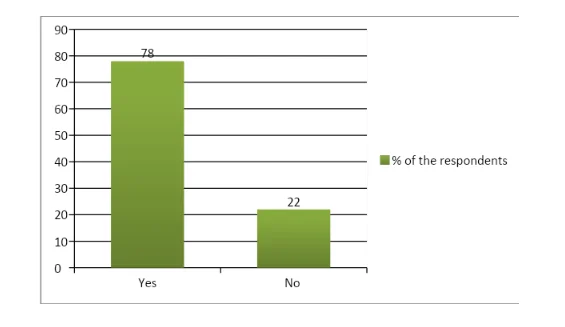
7. According to you, the training program is effective to?

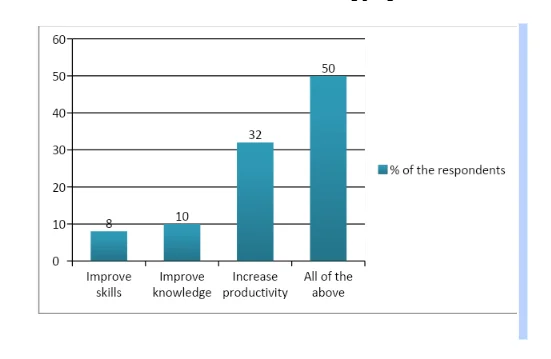
8. Are you satisfied with the training environment in the organisation and infrastructure available at the organisation?


9. Does the training program build up teamwork?


10. Does the training program innovative?


11. Does the training program increase leadership skill and improve engagement with the employees?


12. What do you suggest to improve the training and development program?


Interview questions:
Question 1: What are the different types of training methods?

Question 2: Does the training improve employee’s competences and how the training is effective for enhancing the performance of the employees?
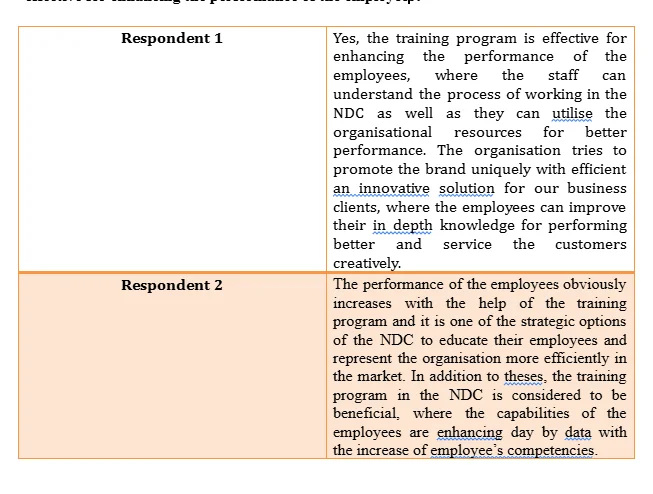

5. Discussion
It is possible to discuss the findings in order to investigate the impacts of training and development program in the organisation NDC. As per the data, collected through the questionnaire survey, most of the employees agree that the providing training and development program to the employees is one of the strategic planning of the organisation NDC to enhance the organisational performance ad satisfy the business clients. Hereby, providing training is an effective organisational strategic planning, which will help the company to enhance their performance and improve the capabilities of the staff for fulfilling the business requirements and contributing positively to maximise the organisational values (Dhar, 2015). It has been that, the employees prefer on the job training program as compared to the off job training, but the organisation NDC focuses on induction and off the job training for improving the knowledge and capabilities of the employees. As per the findings, the organisation mainly focuses on conferences and off the job training for maximising the abilities and knowledge of the junior staff members in the organisation. It is important for the organisations in the recent years to arrange the training program on the real life experience as well as on the job process so that the staff members can maximise their abilities to perform better (Van Wingerden, Derks and Bakker, 2017). Most of the employees stated that, the training program has been happened once in a year and some stated that there is training program on a half yearly basis in the organisation, but it can be considered to be disadvantageous for the company, as it is necessary to arrange frequent training program for enhancing the organisational performance. As per the feedback from the junior staff members in NDC, the training program is effective for improving productivity and leadership skill as well as it enhances the quality and quality of the performance. In this context, according to Alagaraja and Shuck (2015), training program is beneficial for improving employee’ performance and it further helps to improve the critical analysis of the employees which is important for the staff to acknowledge the requirements of the business clients and support the customers with efficient service. As per the findings, most of the junior staff members have stated that, they are interested to participate in the training program to improve their personal and professional development. It is advantageous for the companies to arrange proper training program and provide a chance to all the staff for their personal and professional development plan, so that they can improve their knowledge and technical skill and this is considered to be an effective way to retain more efficient staff in the organisation (Zeng, Phan and Matsui, 2015). The organisation focuses on arranging effective training and development program for improving their performance where the employees can enhance their productivity and improve the basic knowledge and technical skill to perform according to the business operational process and customer’s requirements by utilising the organisational resources successfully. Training environment plays another curial role, where the organisation needs to be concerned about the availability of latest technology as well as physical environment with transparency and accountability and computerised system so that the employees can have the opportunity to improve their technical knowledge (Kang, Gatling and Kim, 2015). In this regard, most of the junior staff in NDC provided neutral answer about the satisfaction level among them about the organisational training environment. Additionally, as per the findings, most of the employees agree that, the training program enhances team work as well as improve the leadership skill which is effective to perform as a team and fulfil the common aim of the organisation. As stated by Sloman (2017), the training program is beneficial for the workers to develop an effective team work and improve engagement where they can share their skill and abilities with each other for better performance as a group to fulfil the organisational mission. All the junior staffs have suggested that, the organisation needs to improve their training program and upgrade the method for providing practical based training. In the recent years, the employees need to understand the market trend and improve their technical skill for better performance and in this regard, it is necessary to provide practical based and on the job training for better performance (Noe et al., 2017).
As per the findings from the interview transcript, the member of the management team stated that, there is different training and development program in the organisation, through which, the organisation NDC aims to achieve high growth. The major training and development programs are induction process, off the job training program, which are beneficial to provide a scope to the employees in order to understand their roles and responsibilities in the organisation and the way to perform better by utilising the organisational resources. In addition to these, under the off the job training program, there are some lectures, case studies, role playing and management games through which the junior staff members can understand the working practice and shadowing off the professional skill from the senior team members in the NDC team. As per the feedback from the management team, it can be stated that, the training and development program is effective for developing soft skill among the employees, where the employees are motivated to communicate, cooperate and coordinate with each other for maximising the organisational performance as a whole. On the other hand, another respondent stated that, the organisation develops working in partnership practice for sharing knowledge and skill among each other which is effective for developing personal and professional skill. Off the job training in this regard plays a crucial role in organisation to promote working practice, motivate the employees to take active part in the organisational operations so that they can perform well and maximise the organisational mission and vision (Guerci et al., 2015). The training and development program in the organisation provides a scope to the company to enhance their overall performance and satisfy the business clients by delivering creative and innovative solution by gathering authentic data and analysing the information strategically.
6. Conclusion
As per the data analysis and findings, it has been seen that, there is crucial impacts of the training and development program on the organisational performance in NDC. It is necessary for the organisation to arrange proper training program to provide an opportunity to all the junior staff of NDC to enhance their in depth knowledge and technical skill so that they can perform better and contribute on the organisational success proficiently. According to the analysis, the objectives are fulfilled well, where the first objective is to identify the training methods in NDC which are off the job training, induction process and conferences and lectures through which the management team of NDC try to provide proper information and educate the employees for performing better according to the customer’s requirements. The second objective of the sty is to acknowledge the impacts of training program which has also been fulfilled by the analysis, where it has been explored that, the training and development program is beneficial for the organisation to enhance their performance and it also provides a scope to the employees to improve their leadership skill, develop team work and improve engagement to perform as a partnership working with communication and cooperation.
7. Recommendation
It is necessary to recommend suitable suggestions for the organisation NDC to improve their training program for educating the employees and improving their technical skill so that they become efficient in data analysis and presentation and fulfil the clients’ requirements. The recommendations are,
Developing the technical training program, so that the software of data analysis can be utilises properly. In this regard, the software presented in the organisation needs to be utilised, where the organisation needs to provide proper technical training to all the employees, so that they can handle he software and conduct the data analysis proves efficiently.
The environment of the organisation needs to improved where proper availability o the physical infrastructure, processor, and Information and Communication Technology (ICT) needs to be implemented for improving innovation and creativity. It further helps the manager to motivate the junior staff and encourage them to take active part in the training and development program and gather ideas of latest technology and software of data analysis.
The manager of NDC needs to arrange on the job training process, where practical based and experience based training need to be provide to all the employees, so that the junior staff can be acknowledged with real life market analysis and data evaluation according to the needs and preferences of the business clients.
Reference List
Alagaraja, M. and Shuck, B., 2015. Exploring organizational alignment-employee engagement linkages and impact on individual performance: A conceptual model. Human Resource Development Review, 14(1), pp.17-37.
Berman, E.M., Bowman, J.S., West, J.P. and Van Wart, M.R., 2019. Human resource management in public service: Paradoxes, processes, and problems. London: CQ Press.
Bratton, J. and Gold, J., 2017. Human resource management: theory and practice. London: Palgrave.
Brewster, C., 2017. Policy and practice in european human resource management: The Price Waterhouse Cranfield survey. Berlin: Taylor & Francis.
Chelladurai, P. and Kerwin, S., 2018. Human resource management in sport and recreation. London: Human Kinetics.
Guerci, M., Radaelli, G., Siletti, E., Cirella, S. and Shani, A.R., 2015. The impact of human resource management practices and corporate sustainability on organizational ethical climates: An employee perspective. Journal of Business Ethics, 126(2), pp.325-342.
Hanaysha, J., 2016. Examining the effects of employee empowerment, teamwork, and employee training on organizational commitment. Procedia-Social and Behavioral Sciences, 229, pp.298-306.
Kang, H.J., Gatling, A. and Kim, J., 2015. The impact of supervisory support on organizational commitment, career satisfaction, and turnover intention for hospitality frontline employees. Journal of Human Resources in Hospitality & Tourism, 14(1), pp.68-89.
Noe, R.A., Hollenbeck, J.R., Gerhart, B. and Wright, P.M., 2017. Human resource management: Gaining a competitive advantage. New York, NY: McGraw-Hill Education.
Noe, R.A., Hollenbeck, J.R., Gerhart, B. and Wright, P.M., 2017. Human resource management: Gaining a competitive advantage. New York, NY: McGraw-Hill Education.
Sparrow, P., Brewster, C. and Chung, C., 2016. Globalizing human resource management. London: Routledge.
Van Wingerden, J., Derks, D. and Bakker, A.B., 2017. The impact of personal resources and job crafting interventions on work engagement and performance. Human Resource Management, 56(1), pp.51-67.
Zeng, J., Phan, C.A. and Matsui, Y., 2015. The impact of hard and soft quality management on quality and innovation performance: An empirical study. International journal of production economics, 162, pp.216-226.
- 24/7 Customer Support
- 100% Customer Satisfaction
- No Privacy Violation
- Quick Services
- Subject Experts



